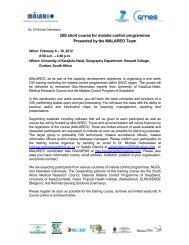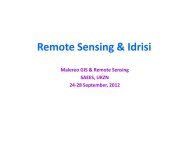Practical Manual - Malareo
Practical Manual - Malareo
Practical Manual - Malareo
You also want an ePaper? Increase the reach of your titles
YUMPU automatically turns print PDFs into web optimized ePapers that Google loves.
Next you will create a line layer (line layers are also refered to as polyline layers, poly meaning many) for<br />
the roads.<br />
To do this, add the layer HC_roads to the legend. (This is a blank line layer with attribute fields called<br />
Road and Length)<br />
Scale and accuracy<br />
An important consideration when digitizing , is the scale (Zoom) at which you will digitize. This is highly<br />
dependant on the needs tof the work you are doing and the required precision. If you zoom out too<br />
much you will not be able to see details in an image. But is you zoom in too much sometimes depending<br />
on the quality of an image you will also not be able to see a lot.<br />
This is shown below:<br />
Too zoomed out<br />
Too Zoomed in<br />
On the image on the left it is too zoomed out to allow for accurate digitizing (You need to be able to<br />
accurately or precisely follow roads. On the image on the right you are so far zoomed in that the image<br />
appears distorted. Therefore a balance needs to be found.<br />
It also helps to maximize the size of your QGIS window. This gives you a larger view of the layers.<br />
Maximize your GIS window. In order to set your zoom type 1:500 into the zoom window in the status<br />
bar at the bottom of the QGIS window. Of course if you are digitizing at a provincial level you would<br />
zoom out a lot more 1:10 000 for example<br />
In this case 1:500 is a reasonable scale to digitize at as it allows objects to be seen clearly.<br />
QGIS for Malaria Page 25




